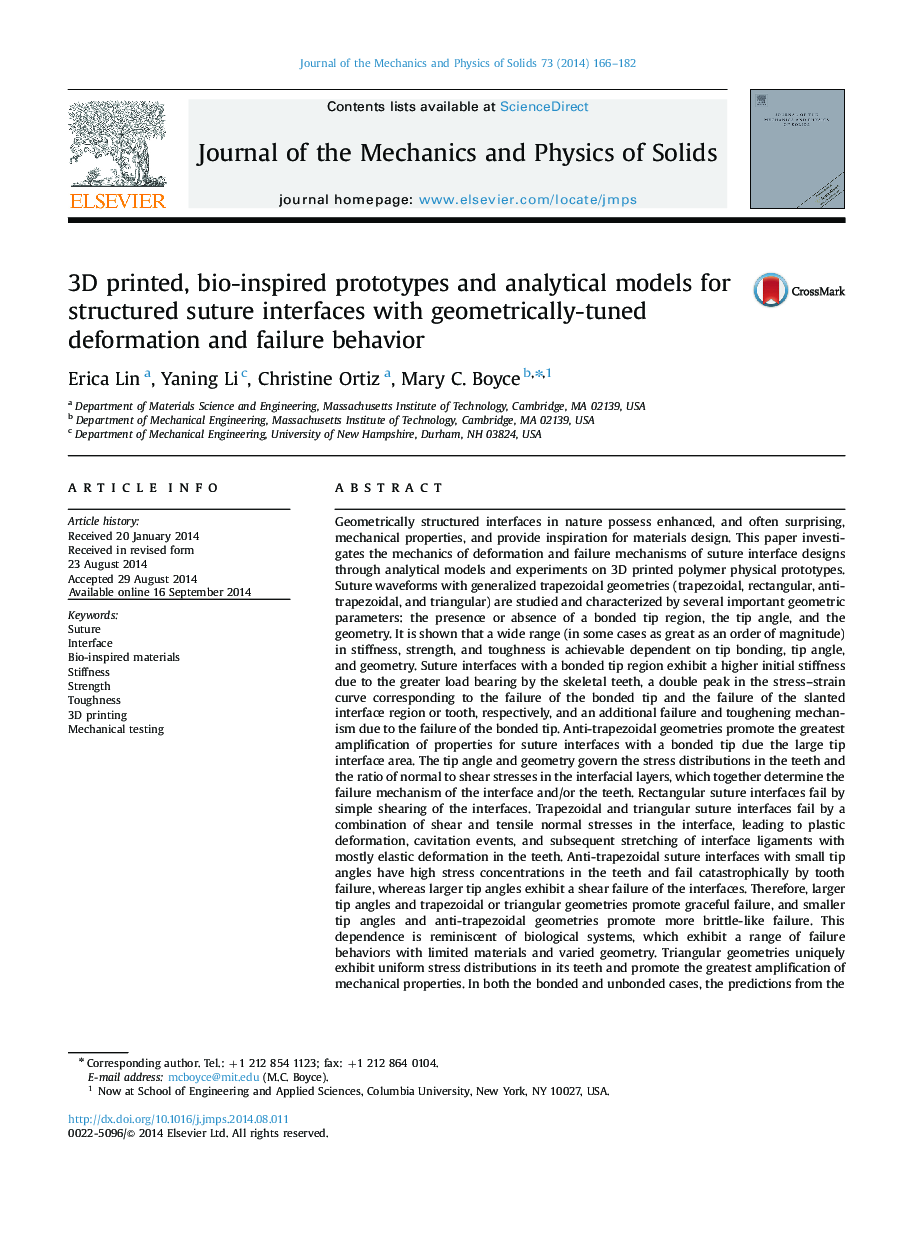| کد مقاله | کد نشریه | سال انتشار | مقاله انگلیسی | نسخه تمام متن |
|---|---|---|---|---|
| 7178151 | 1467070 | 2014 | 17 صفحه PDF | دانلود رایگان |
عنوان انگلیسی مقاله ISI
3D printed, bio-inspired prototypes and analytical models for structured suture interfaces with geometrically-tuned deformation and failure behavior
دانلود مقاله + سفارش ترجمه
دانلود مقاله ISI انگلیسی
رایگان برای ایرانیان
کلمات کلیدی
موضوعات مرتبط
مهندسی و علوم پایه
سایر رشته های مهندسی
مهندسی مکانیک
پیش نمایش صفحه اول مقاله

چکیده انگلیسی
Geometrically structured interfaces in nature possess enhanced, and often surprising, mechanical properties, and provide inspiration for materials design. This paper investigates the mechanics of deformation and failure mechanisms of suture interface designs through analytical models and experiments on 3D printed polymer physical prototypes. Suture waveforms with generalized trapezoidal geometries (trapezoidal, rectangular, anti-trapezoidal, and triangular) are studied and characterized by several important geometric parameters: the presence or absence of a bonded tip region, the tip angle, and the geometry. It is shown that a wide range (in some cases as great as an order of magnitude) in stiffness, strength, and toughness is achievable dependent on tip bonding, tip angle, and geometry. Suture interfaces with a bonded tip region exhibit a higher initial stiffness due to the greater load bearing by the skeletal teeth, a double peak in the stress-strain curve corresponding to the failure of the bonded tip and the failure of the slanted interface region or tooth, respectively, and an additional failure and toughening mechanism due to the failure of the bonded tip. Anti-trapezoidal geometries promote the greatest amplification of properties for suture interfaces with a bonded tip due the large tip interface area. The tip angle and geometry govern the stress distributions in the teeth and the ratio of normal to shear stresses in the interfacial layers, which together determine the failure mechanism of the interface and/or the teeth. Rectangular suture interfaces fail by simple shearing of the interfaces. Trapezoidal and triangular suture interfaces fail by a combination of shear and tensile normal stresses in the interface, leading to plastic deformation, cavitation events, and subsequent stretching of interface ligaments with mostly elastic deformation in the teeth. Anti-trapezoidal suture interfaces with small tip angles have high stress concentrations in the teeth and fail catastrophically by tooth failure, whereas larger tip angles exhibit a shear failure of the interfaces. Therefore, larger tip angles and trapezoidal or triangular geometries promote graceful failure, and smaller tip angles and anti-trapezoidal geometries promote more brittle-like failure. This dependence is reminiscent of biological systems, which exhibit a range of failure behaviors with limited materials and varied geometry. Triangular geometries uniquely exhibit uniform stress distributions in its teeth and promote the greatest amplification of mechanical properties. In both the bonded and unbonded cases, the predictions from the presented analytical models and experimental results on 3D printed prototypes show excellent agreement. This validates the analytical models and allows for the models to be used as a tool for the design of new materials and interfaces with tailored mechanical behavior.
ناشر
Database: Elsevier - ScienceDirect (ساینس دایرکت)
Journal: Journal of the Mechanics and Physics of Solids - Volume 73, 15 December 2014, Pages 166-182
Journal: Journal of the Mechanics and Physics of Solids - Volume 73, 15 December 2014, Pages 166-182
نویسندگان
Erica Lin, Yaning Li, Christine Ortiz, Mary C. Boyce,